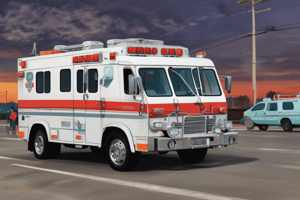Podcast
Questions and Answers
What is the purpose of the Patient Care Reporting & Quality Review policy?
What is the purpose of the Patient Care Reporting & Quality Review policy?
To establish the minimum requirements for patient care reporting and quality review by the St. John's Fire District.
What ePCR software is approved for use by the St. John's Fire District?
What ePCR software is approved for use by the St. John's Fire District?
The ImageTrend 'Field' software is the approved ePCR software.
Within what timeframe must ePCRs be completed after an incident notification?
Within what timeframe must ePCRs be completed after an incident notification?
ePCRs must be completed within twenty-four hours.
What should the ePCR narrative include?
What should the ePCR narrative include?
Why is accurate information critical in patient care reporting?
Why is accurate information critical in patient care reporting?
What should be documented as the chief complaint during patient care reporting?
What should be documented as the chief complaint during patient care reporting?
What does the primary assessment include?
What does the primary assessment include?
What types of information should be included in the ongoing assessment?
What types of information should be included in the ongoing assessment?
What must an EMT or Paramedic include during the patient turnover to the transporting EMS agency?
What must an EMT or Paramedic include during the patient turnover to the transporting EMS agency?
How can airway placement be confirmed according to the guidelines?
How can airway placement be confirmed according to the guidelines?
Flashcards are hidden until you start studying
Study Notes
Patient Care Reporting & Quality Review Overview
- Establishes minimum requirements for patient care reporting and quality review by St. John's Fire District (STJFD).
- Aims for standardized processes in patient care reporting and assurance.
Electronic Patient Care Reporting (ePCR)
- ImageTrend "Field" software adopted for documenting patient encounters.
- All fields in ePCR must be completed accurately.
- ePCRs to be completed within 24 hours of incident notification per DHEC Standard 61-7.
- Vital signs must be documented for each encounter, forming part of the patient's medical record.
ePCR Narrative Requirements
- Narratives are crucial for explaining treatment details and should follow a chronological format.
- Key sections include:
- Dispatched To: Describe the initial call and units dispatched.
- Upon Arrival: Overview of the incident scene.
- Chief Complaint: Document the expressed complaints.
- Primary Assessment: Include patient impressions, consciousness, airway, and circulation status.
- Secondary Assessment: Detailed physical examination information such as lung sounds and glucose levels.
- Treatments: Record all treatments and abnormal vital signs.
- Ongoing Assessment: Note patient responses to treatments.
- Notes: Document the patient turnover to the transport agency.
Notifications and AED Use
- Immediate notification to STJFD Medical Battalion Chief required when an AED is used for data collection and record-keeping.
Patient Refusals
- Patients refusing care must have a STJFD refusal form completed and signed.
- ePCR must reflect patient orientation and education related to the refusal.
- Refusal forms should be uploaded in PDF format; if scanning is not possible, follow proper envelope procedure to ensure compliance.
Medical Quality Assurance Process
- Aims to ensure professional and systematic emergency medical care.
- Review responsibility lies with the Medical Battalion Chief, command staff, and Medical Director.
- Company officers must verify completion of patient care reports.
Levels of Review for Quality Improvement
- Level 1 Review: Triggered by significant incidents (e.g., cardiac arrest, airways inserted, patient refusals). Assignments must be processed within 14 days.
- Level 2 Review: Triggered by identified infractions beyond documentation errors; handled by Medical Battalion Chief.
- Level 3 Review: Conducted by Command Staff upon severe findings from Level 2; may require intervention from the Medical Director.
Key Points to Remember
- Accurate reporting impacts patient care and medical records.
- Compliance with protocols is essential for quality assurance.
- Each level of review escalates if issues are not resolved at a lower level.
- Timely completion and meticulous documentation uphold the integrity of the emergency medical services provided.
Studying That Suits You
Use AI to generate personalized quizzes and flashcards to suit your learning preferences.




